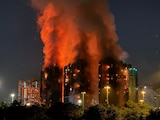- Maxar Technologies released satellite images showing damage to Iran's military facilities.
- The conflict escalated after Israel's preemptive strike on Iran over nuclear program concerns.
- Iran retaliated by launching missiles at Israel amid ongoing military confrontations.
Maxar Technologies has released high-resolution satellite images showing the extensive damage which has been inflicted by Israel on Iran's military and nuclear facilities as the two enemies continue to pound each other for the fifth straight day. The satellite images help paint a clearer picture of what's happening on the ground amid internet and media restrictions in the Islamic Republic.
The military confrontation between the two enemy nations started after Israel launched a "preemptive" attack on Iran last Friday, accusing Tehran of pursuing a nuclear weapons programme in defiance of global warnings, despite Tehran's insistence that its nuclear programme is for civilian purposes only. Iran has retaliated to Israeli aggression by raining missiles on the Jewish state.
The new images from June 15 show the extent of damage at Kermanshah missile facility, Shiraz missile and electronics production facilities, Bid Kaneh missile, and Natanz enrichment facility due to the Israeli aggression. They came a day after the Israeli military on Monday said that it was striking surface-to-surface missile sites in Iran.
"The IDF is currently striking surface-to-surface missile sites in central Iran," Israel Defence Forces (IDF) spokesman Nadav Shoshani wrote on X. "We are operating against this threat in our skies and in Iranian skies."
At the missile base operated by Iran's Islamic Revolutionary Guard Corps (IRGC) near the western province of Kermanshah, images show multiple buildings damaged by Israeli attacks, with debris scattered around the site.
Image shows destroyed buildings at entrance to Kermanshah Missile Facility | See hi-res image here
Photo Credit: Satellite image ©2025 Maxar Technologies
Damage can also be seen in various tunnel entrances up against the mountainside, which are likely used to conceal and hide missile-related equipment away from attacks.
Image shows close-up view of damaged tunnel entrances Kermanshah Military Facility | See hi-res image here Photo Credit: Satellite image ©2025 Maxar Technologies
Iran is know to burry its ballistic missiles deep in underground silos spread out across the country.
Image shows overview of fires burning at Shiraz Military Facility | See hi-res image here
Photo Credit: Satellite image ©2025 Maxar Technologies
Israel also struck the Shiraz military and electronics facilities in Fars Province. Images of the missile facility show active fires and burned vegetation around the premises; however, no signs of destroyed buildings or vehicles can be observed. Missile facilities reportedly manufacture, repair, and store Iranian ballistic missiles.
Image shows burning buildings at Shiraz Electronics Production Facility | See hi-res image here
Photo Credit: Satellite image ©2025 Maxar Technologies
However, heavy smoke and active fires can be observed in and around the Shiraz electronics facility that produces electronics for the Iranian military.
Image shows damaged buildings and dispersed vehicles at Bid Kaneh Military Facility | See hi-res image here. Photo Credit: Satellite image ©2025 Maxar Technologies
Images also show damage sustained at the Shahid Modarres Garrison rocket production facility near Bid Kaneh, south-west of Tehran. Multiple buildings can be seen destroyed by Israeli strikes in the images. Dozens of trucks, vehicles and other equipment were relocated and dispersed throughout the site, possibly to hide the extent of damage.
Image shows a closer view of the damaged building at Bid Kaneh Military Facility | See hi-res image here
Photo Credit: Satellite image ©2025 Maxar Technologies
Bid Kaneh is reportedly one of Iran's key ballistic missile facilities, where Tehran also manufactures its drones, according to a Reuters report.
Image shows closer view of new vehicle tracks and dirt piles over underground centrifuge facility at Natanz Enrichment Facility | See hi-res image here. Photo Credit: Satellite image ©2025 Maxar Technologies
Images of Iran's biggest uranium enrichment plant at Natanz revealed new vehicle activity in the dirt that covers the underground centrifuge buildings. N nuclear watchdog chief told the BBC on Monday that it was very likely all the roughly 15,000 centrifuges operating at the Natanz facility were badly damaged or destroyed because of a power cut caused by an Israeli strike.
The latest images show vehicle tracks and small dirt piles, which correlate to the same areas where the craters were seen on images released on June 14. This could have been done to conceal or cover the craters.
Israel on Tuesday said it targeted military sites in Iran and killed a senior commander in fresh strikes, prompting Tehran to fire missiles in retaliation on the fifth day of escalating clashes between the arch foes.
Explosions were also heard over Tel Aviv and Jerusalem in the morning, shortly after air raid sirens sounded across parts of Israel following missile launches from Iran, the Israeli military said.















